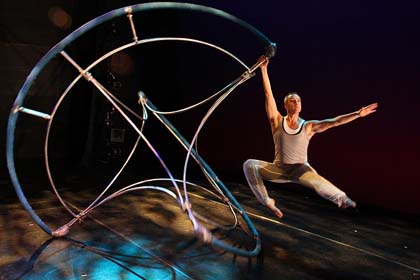|


Jack Anderson
Questions About Angels
Joseph Mills
" Questions About Angels"
Theater for the New City
January 13-22 (closed)
Reviewed by Jack Anderson, January 24, 2012
 |
| "Icarus
Aspires" -- Joseph Mills and Circle Walker sculpture by Alan
Boeding. Photo by Jeff Greenberg. |
Angels are both puzzling and appealing. Although they are supposedly
amorphous and sexless beings, they can be depicted by humans only
in material terms, artists and writers making them often radiantly
beautiful and even sexy. They can be physically powerful, as well.
The peculiar nature of angels prompted Billy Collins to write "Questions
About Angels," the title poem of his collection of 1991. That
poem, in turn, became one of the inspirations for Joseph Mills’s
suite of little dances, also called "Questions About Angels."
 |
| "Balthamos
and Baruch or Jacob Wrestling the Angel"--John-Mario Sevilla
(L) and Joseph Mills (R). Photo by Lee Wexler/Images for Innovation. |
Collins’s witty and gently philosophical angelic inquiries
usually proved more interesting than those of Mills. One reason why
has to do with the nature of their media. Poetry, like any other verbal
medium, can summon up all sorts of realistic or fantastic things.
Yet words are not those things: they are evocative marks on paper,
and poets can tell without also literally showing. Dance, however,
must of necessity be specific, for it is an art involving solid bodies,
requiring choreographers to show as well as tell what’s on their
minds. Although Collins can easily ask, do angels "fly through
God’s body and come out singing?", choreographers who try
to express this idea (which, perhaps fortunately, Mills did not) might
all too readily turn angelic flying and singing into lumbering activities.
|
| "On
the Head of a Pin"-- Samantha Benventano. Photo by Lee Wexler/Images
for Innovation |
Mills made the Collins poem only a springboard for his own excursions
into angelology, and there were times when his dancing bodies did
indeed appear to dematerialize. Thus, in "Bodies of Light,"
dancers who seemed to be shrouded with cobwebs looked believably spectral
as they materialized from and returned to darkness while shining light
upon themselves from hand-held flashlights. And "Icarus Aspires,"
adapted from a dance choreographed and designed by Alan Boeding ,
found Mills encased inside a revolving sculpture, hanging on, leaning
forward, and swinging about with the greatest of ease. This was an
Icarus who would never plummet to earth. In total contrast was "Balthamos
and Baruch or Jacob Wrestling the Angel," a strenuously muscular
duet in which Mills and John-Mario Sevilla, both wearing jeans, contended
fiercely in a biblically based reminder that, in some traditions angels
can be mighty warriors.
Three women emerged from cocoons in "On the Head of a Pin":
a striking image. But then they did little more than waft and swirl
around the stage. A specific image gave way to vagueness. And that
was true of too many of the work’s other scenes, so that it
sometimes became difficult to ascertain what questions Mills was asking
about his angels and what he thought the answers might be. Yet he
did make a brave attempt to dance into the empyrean.
|
